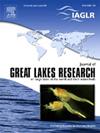Spatial genetic structure of upper Great Lakes burbot (Lota lota)
IF 2.4
3区 环境科学与生态学
Q3 ENVIRONMENTAL SCIENCES
引用次数: 0
Abstract
The population abundance and distribution of many Great Lakes fish species, particularly those that are adapted to cold water, have changed greatly in recent times due in part to changes in physical lake and biotic environments. Burbot (Lota lota) is an understudied cold water benthivore of conservation concern. To characterize levels of genetic diversity and spatial genetic structure associated with historical phylogeographic isolation or contemporary reproductive isolation, microsatellite genotypes and mitochondrial DNA sequences were analyzed for burbot (n = 253) collected from 14 open water locations in Lakes Huron, Michigan, and Superior and the upper St. Clair River. Spatial variation in levels of diversity and degree of genetic distinction among samples in different geographic locations was most evident over broader geographic scales between Lake Superior and Lakes Michigan and Huron. Members of open-water sampling locations within basins did not differ significantly in microsatellite allele or mtDNA haplotype frequency. Data from this study and from previous results in other North American locations indicated that burbot sampled from the upper Great Lakes likely originated from multiple glacial refugia, and that geographic representations were admixed at the lake basin level. Analyses differentiating populations of burbot will inform managers how to appropriately target the genetically differentiated populations to support species management.
五大湖上游河狸(Lota Lota)空间遗传结构
近代以来,由于湖泊物理环境和生物环境的变化,许多五大湖鱼类,特别是那些适应冷水的鱼类,其种群数量和分布发生了很大变化。伯宝鱼(Lota lota)是一种未得到充分研究的冷水底栖动物,其保护问题备受关注。为了描述与历史上的系统地理隔离或当代的生殖隔离相关的遗传多样性水平和空间遗传结构,我们分析了从休伦湖、密歇根湖、苏必利尔湖和圣克莱尔河上游的 14 个开放水域采集的水豚(n = 253)的微卫星基因型和线粒体 DNA 序列。在苏必利尔湖与密歇根湖和休伦湖之间较宽的地理范围内,不同地理位置样本之间的多样性水平和遗传差异程度的空间差异最为明显。流域内开阔水域采样点的成员在微卫星等位基因或 mtDNA 单倍型频率方面没有显著差异。这项研究的数据以及之前在北美其他地区的研究结果表明,从五大湖上游采样的大菱鲆可能来自多个冰川避难所,在湖泊流域层面的地理代表性是混合的。通过分析大菱鲆种群的差异,管理者将了解如何适当地针对基因差异种群进行物种管理。
本文章由计算机程序翻译,如有差异,请以英文原文为准。
求助全文
约1分钟内获得全文
求助全文
来源期刊

Journal of Great Lakes Research
生物-海洋与淡水生物学
CiteScore
5.10
自引率
13.60%
发文量
178
审稿时长
6 months
期刊介绍:
Published six times per year, the Journal of Great Lakes Research is multidisciplinary in its coverage, publishing manuscripts on a wide range of theoretical and applied topics in the natural science fields of biology, chemistry, physics, geology, as well as social sciences of the large lakes of the world and their watersheds. Large lakes generally are considered as those lakes which have a mean surface area of >500 km2 (see Herdendorf, C.E. 1982. Large lakes of the world. J. Great Lakes Res. 8:379-412, for examples), although smaller lakes may be considered, especially if they are very deep. We also welcome contributions on saline lakes and research on estuarine waters where the results have application to large lakes.
 求助内容:
求助内容: 应助结果提醒方式:
应助结果提醒方式:


